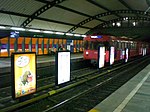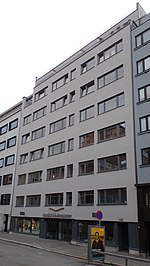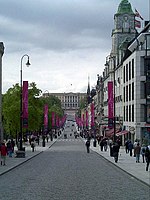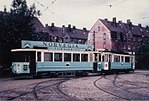Øvre Slottsgate tram stop
Norway tram stubsOslo Tramway stations in Oslo
Øvre Slottsgate is a tram/light rail station on the Vika Line. The station is served by lines 11, 12 and 13. Thus, it is operated with SL79 high-floor trams and SL95 low-floor trams. Øvre Slottsgate is a short minute walk from bus stations Kvadraturen, Wessels Plass and the now defunct bus and tram stop, Christiania Torv. Nationaltheatret (11,13) and Kontraskjæret (12) are stations succeeding Øvre Slottsgate westbound, while Dronningens gate succeeds Øvre Slottsgate eastbound. The station is also close to the Stortinget station, so it is easy to transfer between the tramway and the metro.
Excerpt from the Wikipedia article Øvre Slottsgate tram stop (License: CC BY-SA 3.0, Authors).Øvre Slottsgate tram stop
Prinsens gate, Oslo Sentrum
Geographical coordinates (GPS) Address Nearby Places Show on map
Geographical coordinates (GPS)
| Latitude | Longitude |
|---|---|
| N 59.911666666667 ° | E 10.741944444444 ° |
Address
Bragegården
Prinsens gate
0157 Oslo, Sentrum
Norway
Open on Google Maps








